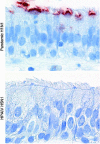Pigs, poultry, and pandemic influenza: how zoonotic pathogens threaten human health
- PMID: 22125035
- PMCID: PMC7123639
- DOI: 10.1007/978-1-4614-0204-6_6
Pigs, poultry, and pandemic influenza: how zoonotic pathogens threaten human health
Abstract
Emerging infections have an enormous impact on human health, food supply, economics, and the environment. Animals, and wild animals in particular, are considered to be the source of more than 70% of all emerging infections in humans. Two zoonotic influenza viruses that successfully spread from animals to humans are highly pathogenic avian influenza (HPAI) H5N1 virus, originating from poultry, and pandemic H1N1 influenza (pH1N1) virus, thought to originate from domestic swine. In this review, we discuss our research on the host species barrier for these viruses, concentrating on three questions: how does HPAI H5N1 virus transmit from birds to humans; what are the within-host dynamics of HPAI H5N1 virus and pH1N1 virus in humans and other mammals; and what determines transmission of influenza viruses among humans. To contain and eradicate zoonotic influenza viruses requires not only strategic virus surveillance of both animal and human populations, but also a better understanding of the hurdles that such a virus needs to jump over in order to cross the species barrier and cause a human pandemic. Advances in these two areas will allow us to better predict the risk of emergence of zoonotic influenza viruses in the human population.
Figures






Similar articles
-
Increasing genetic diversity of H5N6 avian influenza virus in China: A serious threat to persistence and dissemination in Guangdong province.J Infect. 2017 Dec;75(6):586-590. doi: 10.1016/j.jinf.2017.10.003. Epub 2017 Oct 14. J Infect. 2017. PMID: 29037866 No abstract available.
-
Human infections with avian influenza viruses in mainland China: A particular risk for southeastern China.J Infect. 2017 Sep;75(3):274-276. doi: 10.1016/j.jinf.2017.05.002. Epub 2017 May 11. J Infect. 2017. PMID: 28502581 No abstract available.
-
Aerosolized avian influenza A (H5N6) virus isolated from a live poultry market, China.J Infect. 2017 Jan;74(1):89-91. doi: 10.1016/j.jinf.2016.08.002. Epub 2016 Aug 9. J Infect. 2017. PMID: 27519618 No abstract available.
-
When Pigs Fly: Pandemic influenza enters the 21st century.PLoS Pathog. 2020 Mar 19;16(3):e1008259. doi: 10.1371/journal.ppat.1008259. eCollection 2020 Mar. PLoS Pathog. 2020. PMID: 32191770 Free PMC article. Review. No abstract available.
-
Influenza viruses: from birds to humans.Hum Vaccin Immunother. 2012 Jan;8(1):7-16. doi: 10.4161/hv.8.1.18672. Epub 2012 Jan 1. Hum Vaccin Immunother. 2012. PMID: 22251997 Review.
Cited by
-
Immunity to Respiratory Infection Is Reinforced Through Early Proliferation of Lymphoid TRM Cells and Prompt Arrival of Effector CD8 T Cells in the Lungs.Front Immunol. 2019 Jun 14;10:1370. doi: 10.3389/fimmu.2019.01370. eCollection 2019. Front Immunol. 2019. PMID: 31258537 Free PMC article.
-
Influenza Vaccines: Successes and Continuing Challenges.J Infect Dis. 2021 Sep 30;224(12 Suppl 2):S405-S419. doi: 10.1093/infdis/jiab269. J Infect Dis. 2021. PMID: 34590139 Free PMC article.
-
Higher Viral Stability and Ethanol Resistance of Avian Influenza A(H5N1) Virus on Human Skin.Emerg Infect Dis. 2022 Mar;28(3):639-649. doi: 10.3201/eid2803.211752. Emerg Infect Dis. 2022. PMID: 35202523 Free PMC article.
-
Evolution and Introductions of Influenza A Virus H1N1 in a Farrow-to-Finish Farm in Guatemala.Microbiol Spectr. 2023 Feb 14;11(1):e0287822. doi: 10.1128/spectrum.02878-22. Epub 2022 Dec 7. Microbiol Spectr. 2023. PMID: 36475876 Free PMC article.
-
Exploring Disease Management and Control through Pathogen Diagnostics and One Health Initiative: A Concise Review.Antibiotics (Basel). 2023 Dec 23;13(1):17. doi: 10.3390/antibiotics13010017. Antibiotics (Basel). 2023. PMID: 38247576 Free PMC article. Review.
References
Publication types
MeSH terms
LinkOut - more resources
Full Text Sources
Medical

